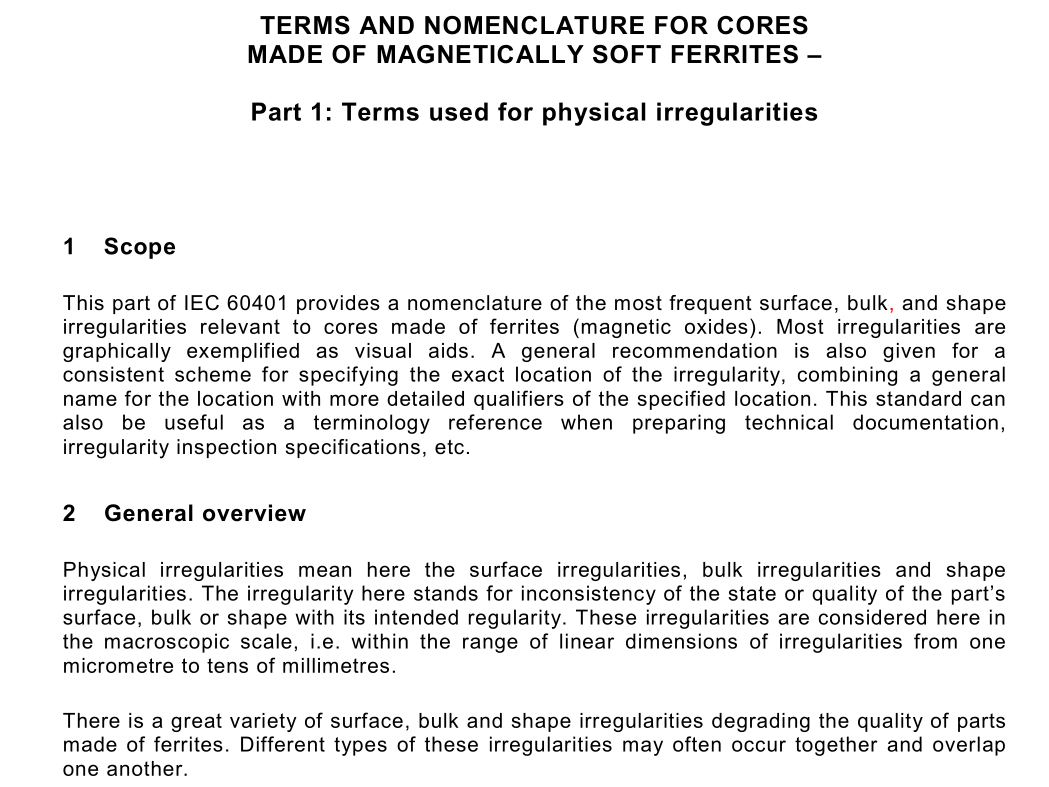IEC 60401-1 pdf download

IEC 60401-1 pdf download.Terms and nomenclature for cores made of magnetically soft ferrites
1 Scope
This part of IEC 60401 provides a nomenclature of the most frequent surface, bulk, and shape irregularities relevant to cores made of ferrites (magnetic oxides). Most irregularities are graphically exemplified as visual aids. A general recommendation is also given for a consistent scheme for specifying the exact location of the irregularity, combining a general name for the location with more detailed qualifiers of the specified location. This standard can also be useful as a terminology reference when preparing technical documentation, irregularity inspection specifications, etc.
2 General overview
Physical irregularities mean here the surface irregularities, bulk irregularities and shape irregularities. The irregularity here stands for inconsistency of the state or quality of the part’s surface, bulk or shape with its intended regularity. These irregularities are considered here in the macroscopic scale, i.e. within the range of linear dimensions of irregularities from one micrometre to tens of millimetres. There is a great variety of surface, bulk and shape irregularities degrading the quality of parts made of ferrites. Different types of these irregularities may often occur together and overlap one another. Each type of irregularity is, in general, produced by one or more of the following: an incorrectly or inaccurately performed manufacturing step, or improper handling, grinding, packing or transportation. The extent of the quality degradation is dependent on the type, scale, and combination of irregularities being present as well as on their locations on the part. There are locations particularly sensitive to the degrading effect of the specific types of irregularities.The irregularities may in extreme cases give a detrimental or critical effect to magnetic, electric and mechanical performances of the part. Operations performed on the part, such as marking, winding, assembling and mounting, can also be adversely affected by the irregularities. An ongoing tendency to upgrade the overall quality of the parts results in more stringent restrictions being imposed on the quantity of irregularities in these parts. This brings about a need for a set of definitions, or nomenclature, which would be a primary basis for approaches to irregularities and their location issues. Therefore, this nomenclature is intended to be used as a uniform reference when formulating more detailed descriptions of irregularities at specified locations, requirements and procedures related to the inspection and assessment of irregularities. This nomenclature can also be useful with regard to methods and tools used for detection, recognition and classification of irregularities.
3 General terms
3.1 surface irregularity unintentional state or appearance of the surfaces, edges and corners of the part NOTE Some surface irregularities, if excessive, can so deform contours and surfaces of the part, that they may also be classified as shape irregularities. 3.2 shape irregularity unintentional deformation of the contour lines or surfaces delimiting the shape of the part NOTE In some cases, shape irregularities smaller than quoted tolerances may still disqualify the part. 3.3 bulk irregularity unintentional inhomogeneity inside the part 3.4 tolerance (dimensional) allowable difference between nominal and permissible limit dimensions of contour lines defining the part’s shape 3.5 location (of the irregularity) position on or within the part where the irregularity is present
7.4 Specific part’s location qualifiers
As a rule the shape determiners as the surfaces, contours, edges, etc. are further qualified by adding more precise qualifying words, usually related to a specific geometry (shape) of the part and/or with the location where the specified irregularity has to be examined. Often these surfaces, walls and their qualifiers are termed according to custom. Nevertheless, it is recommended to follow, as far as possible, the terminology proposed here which is aimed at a more precise and unified classification linking the irregularities with their locations in specific types of parts. Moreover, to avoid any ambiguity, the given locations should be distinctly indicated on a relevant drawing of the concerned part. Examples of such more precise terminology are: upper surface of back (of U-core); lateral wall of outer leg (of E-core); outer circular wall (of pot-core…); back flange wall (of yoke ring core), foot, bevelled wall, end wall (in segment) etc.









